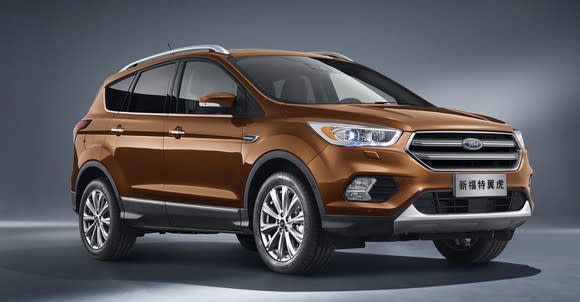Why Ford Continues to Struggle in China
Ford Motor Company (NYSE: F) said its sales in China fell 5% in October from a year ago, as good results for some of its larger and more expensive products were more than offset by significant declines in sales of several key Ford-brand models.
Including October's result, Ford's sales in China are down 5% this year, trailing several key rivals.
Made-in-China Fords are having a rough 2017
Ford has two joint ventures in China. The first, called Changan Ford, or CAF, builds and sells Ford-brand cars and SUVs, most (but not all) of which would be familiar to Americans. The second, called Jiangling Motors, or JMC, builds and sells commercial vans and trucks under the Ford, Yusheng, and JMC brands. It also builds and sells a truck-based SUV called the Everest.
In recent months, JMC has done well while CAF has struggled. JMC's sales were up 6% in October, to 25,275 vehicles, on good results for the Everest, Ford's commercial vans, and several JMC-brand trucks. JMC's success is no surprise; Ford has a long history as a dominant player in the commercial-vehicle markets in both the U.S. and Europe. Year to date, JMC's sales are up 15% through October.

Like its U.S.-market cousin, the Escape, Ford's China-market Kuga got a facelift for 2017. Sales have been good recently. Image source: Ford Motor Company.
Unfortunately for Ford, CAF has had a tougher time in 2017. CAF's sales fell 11% in October from a year ago; they're down 14% year to date. Sales of most Ford-brand models are down by double-digit percentages from a year ago, victims of tough competition from domestic Chinese automakers and faster-moving global rivals.
There were a few relative bright spots for CAF in October. Sales of the Escort, an affordable compact car developed specifically for the China market, rose 6% to nearly 30,000. Sales also rose for the Mondeo, the Chinese-market twin of the Fusion sedan, and the Kuga, twin to the Escape SUV. But sales of all of the other Ford-brand models in CAF's lineup were down in October, and all of them -- including the Escort, Kuga, and Mondeo -- are down year to date.
The bright spots: Ford's imports
Ford also sells vehicles in China that aren't products of its joint ventures; they're imported from Ford factories in other countries. Those include the high-performance ST and RS versions of the Focus, the Mustang, the Explorer, and the high-performance F-150 Raptor, along with all of the Lincoln-brand vehicles sold in China.

Ford imports the Mustang to China from Michigan. Sales are up 38% this year. Image source: Ford Motor Company.
Lincoln has been a very bright spot for Ford this year. All of the Lincolns sold in China are imported from North America and sold through a dealer network that puts a strong emphasis on personalized service. The formula is working: Lincoln sales rose 48% in October, to 5,514 vehicles, and are up 85% year to date. (For comparison, Lincoln sold 8,909 vehicles in the U.S. in October.)
The total number of imported Ford-brand vehicles is small, but they're high-profit models and sales of most have been good in 2017. As a group, sales of imported Ford-brand vehicles rose 13% in October to 1,469. They're up 15% year to date.
What it means: Ford has work to do in China
Ford was late to China relative to its global rivals. It did very well for a few years, but it has lost significant ground to those global rivals in 2017. Year to date through October, Ford's China sales are down 5%, versus increases of 2% for General Motors (NYSE: GM), 8.5% for Toyota (NYSE: TM), and 17% for Honda (NYSE: HMC).
The problem? China's new-car market is fast-moving, and most of the Ford-brand lineup is old news to Chinese consumers at this point. Contrast with GM, which has rolled out several all-new crossover SUVs over the past year and a half. GM is also having huge success with its Baojun brand, created specifically to compete with China's domestic automakers. Baojun sold over 100,000 vehicles last month; its sales are up 45% this year.
The sales slide is showing up on the Blue Oval's bottom line. Equity income from Ford's two Chinese joint ventures fell 25% in the third quarter, to $241 million. CEO Jim Hackett has taken steps to turn things around, installing a new leader for Ford China (Jason Luo) and promising a series of new models.
That will help, but it will take time: Ford may continue to lose ground in China for a while longer.
More From The Motley Fool
6 Years Later, 6 Charts That Show How Far Apple, Inc. Has Come Since Steve Jobs' Passing
Why You're Smart to Buy Shopify Inc. (US) -- Despite Citron's Report
John Rosevear owns shares of Ford and General Motors. The Motley Fool owns shares of and recommends Ford. The Motley Fool has a disclosure policy.

 Yahoo Finance
Yahoo Finance 